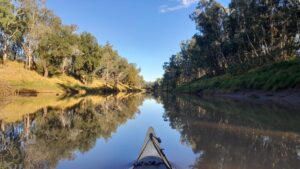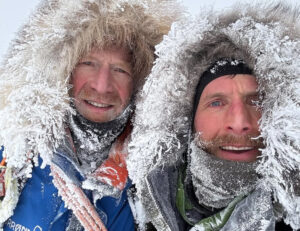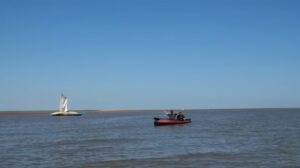The Northwest Passage’s days as a mysterious, notoriously difficult arctic sea route might be numbered. The world is warming and the passage connecting the Atlantic and the Pacific is opening for longer each summer. Kayakers West Hansen, Jeff Wueste, and Rebekah Feaster hope to take advantage of the change to blitz the 3,000km passage in a single season.

Their starting point: Pond Inlet, Nunavut, with Bylot Island across the water. Photo: Jerry Kobalenko
East to west from Pond Inlet
Yesterday, the Arctic Cowboys (all three are from Texas), flew to the town of Pond Inlet (population about 1,600) on northern Baffin Island. Within the next couple of days, they will launch into the passage, paddling east to west. Prior attempts to row and kayak the passage have started from the west, but none finished. Teams put in months of work only to encounter too much sea ice at around the two-thirds point.
“I don’t want to be yet another kayak expedition that paddled from Tuk[toyaktuk] to Gjoa Haven, only to be blocked by ice,” Hansen told me earlier this year when explaining their route choice.

The planned route. Photo: West Hansen
Hansen, Feaster, and Wueste will be paddling small, light Epic 18 kayaks. Wueste and Hansen warmed up by racing the 260-mile Texas Water Safari last month. Feaster recently completed an Ironman triathlon in Switzerland.
However, Hansen notes that they’ve purposefully not put in too much time on the water so that they can put on some fat. “We lose so much weight on these long expeditions that it helps to start with a bit of a gut,” he explained.

West Hansen (centre left) and Jeff Wueste (centre right) after the Texas Water Safari last month. Photo: Texas Water Safari
The crux of the expedition
They have budgeted 60 days to reach their end point at the town of Tuktoyaktuk on the Canadian mainland. Built into this are several down days for stormy weather or too much ice in the passage. The ice is the most critical part of the equation.
“The sea ice is in constant flux, so what may be a clogged route one hour may open up in the next,” Hansen says.
The team has been monitoring the ice while waiting for a flight from Ottawa to Baffin Island. They believe that conditions look promising. The crux of their trip is likely Bellot Strait, a critical one-kilometre-wide, 30km long artery between southern Somerset Island and the Canadian mainland’s Boothia Peninsula. The strait, and the coast of Somerset Island, have proven impassable for some previous attempts to paddle the NWP.

Some summers, the ice in Bellot Strait can still block all ships. In 2018, no vessel made it through the Northwest Passage. Photo: Jerry Kobalenko
Sea ice will be the greatest obstacle
“The sea ice is clearing very quickly. We’re monitoring it every few hours and the changes are drastic. Within a week, our route through those crux areas should be clear,” Hansen says.
“Our kayaks require only six inches of water and most of the fast ice (ice attached to the shoreline) is already gone from the entire route. The thicker drift ice cannot get close enough to the shore, so we may have leads closer to the shore open to us too.”

Kayakers may take advantage of narrow shore leads to pass where other boats cannot, although it means following every contour of the shoreline. Sometimes, the shore lead only exists at high tide. Photo: Jerry Kobalenko
In a worst-case scenario, Hansen says they are prepared to haul over ice floes, though he doubts that it will be required.

The Arctic Cowboys, from left: West Hansen, Rebekah Feaster, and Jeff Wueste. Photo: West Hansen
After a longer-than-expected wait in Ottawa (partly due to sea ice that kept a jet-fuel barge from getting to Pond Inlet to refuel the larger transport jets), the trio now only has a few permits to complete before they hit the water. We’ll follow their progress over the next two months as they exit Baffin Bay and attempt to become the first people to paddle the NWP in a single season.
You can follow their expedition directly here.

The crux sections of the Northwest Passage begin to clear in mid-August, but loose floes drift and can block routes even then. Cruise ships typically attempt the route in September. Above, the state of the NWP as of July 25, with lots of solid ice (red and orange areas) along the kayakers’ route.






